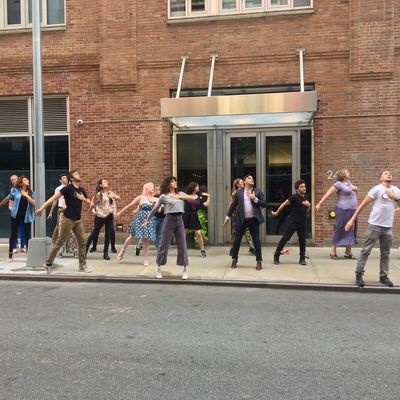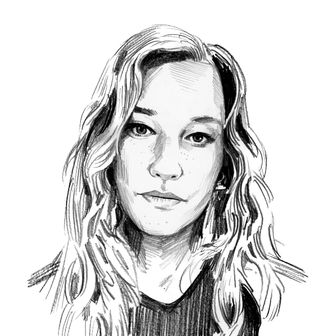
On a sunny, late-summer Monday evening in New York, I walk up to Netflix’s Manhattan headquarters, looking for a flash mob. Instead, I find one woman standing by herself, wearing the millennial version of a Flashdance ensemble: curly bangs, wide-legged pants, a cropped gray sweatshirt. She waves me over with a smile. “Are you here for The OA?” she asks brightly. “We’re practicing down the street. Come with me.”
The woman’s name, I soon learn, is Jess Grippo. She’s responsible — along with friends Ashley Williams and Eduardo Pacer — for organizing the flash mob that’s about to go down in front of Netflix HQ, as well as the one an hour later in Times Square. On a purely surface level, the point of the flash mob, the latest action by the #SavetheOA movement, is to convince Netflix to renew Brit Marling and Zal Batmanglij’s supernatural TV series, starring Marling as a missing blind woman who reappears seven years later with her vision restored. But it quickly becomes clear that the gathering is more about a sort of collective catharsis, a way for likeminded people to come together and find connection inside the cold-sweat grip of late capitalism.
This isn’t Grippo’s first OA-centric dance mob. A former ballerina, she tells me she began watching The OA in 2017 after Trump’s election, and was instantly transfixed by “the idea that movement is healing and powerful — it reminds us that we need art to keep us going, especially in these crazy times.” A few weeks later, she and Williams and Pacer planned a flash mob in front of Trump Tower, where they reenacted what’s known on the show as the “movements,” in an effort to propel him into another dimension. It didn’t work (I think).
On The OA, the movements transport the protagonists across time and space, but only when done in unison and with “perfect feeling.” They represent blind faith, community, and a willingness to be open and vulnerable. On their own, they are a bit difficult to swallow (at first). They’re unnatural and odd. There’s nothing sexy about them. One movement involves putting your hands in front of your mouth like a bird beak; another is a sort of fake stomach stab paired with a hard exhale. But in the context of the show — and the flash mob — the embarrassment is part of the point.
And for a certain subset of people, they are contagious and thrilling. Before Grippo and I can head to the park, we’re stopped by an older woman and her teenage daughter. “Is this the OA flashmob?” she asks. “I’m so excited. Can I take a picture?” Grippo gamely poses for a photo, pulling me into it. I ask the woman why she’s here. “I can’t do the movements, but I really wanted to see them,” she says. “My daughter told me, ‘Watch this show mom, you’re gonna love it.’ I watched it earlier this year and I just fell in love.”
The woman and her daughter, camera in hand, follow us to the park, where Grippo is greeted by two dozen or so people with applause and hugs. The group rehearses the movements several times. It’s imperfect, with some slip-ups and loss of synchronicity, but I find myself getting choked up. I’ve written about the show’s rare hopefulness before, but there’s something even more baldly hopeful about watching a group of strangers — ranging widely in age and race and gender — come together and risk looking slightly ridiculous in public, all because they love a piece of art so much. It’s one of the least cynical things I’ve ever seen.
Across the country, on the corner of Sunset and Van Ness, there’s another uncynical movement unfolding. Emperial Young has been standing outside of Netflix’s Los Angeles headquarters since August 16, and hunger-striking since early last week, partly in an effort to convince Netflix to release the rights of The OA back to its creators. But the protest isn’t just about The OA, as Young explained in a long, five-part thread on Twitter, where she goes by @emverse. The show’s cancellation, she says, is symptomatic of much larger problems: capitalism, greed, the lack of access to mental-health services, and individualism, among other things.
For Young, who’s been supported and trashed online in equal measure, the absurdity of her gesture is the point. “To all the people thinking it is absurd to hunger strike over a TV show: I agree. But you want to know something even more absurd?” she writes. “Tens of thousands of people die in the United States every year because they … cannot afford services to treat mental health issues and medical conditions. Untreated conditions make it harder to obtain employment, making it even more impossible to get help. It’s a capitalist cycle, because in capitalism, an individual who cannot contribute to the system has little to no value.”
That last part is of particular significance to Young. When I call her on Monday night, she’s been standing on the corner all day, holding a handmade sign. I can hear honks of support in the background. She tells me that while she isn’t necessarily a die-hard fan of The OA, she loves the show’s messages of collectivism and sincerity. “When I’m having issues, and I try to reach out and get support, I can’t get anything,” she says. “You leave messages, people don’t call you back. But when things are difficult, you can turn to art. It makes a difference to people who don’t have anything else.”
Young says she’s feeling “great,” despite having eaten nothing for seven days, bolstered by a recent visit from Marling and Zal, who ran out of their car at a red light on her second day of protesting and offered her food and water. “I got a bit starstruck,” says Young. “I didn’t really know how to process it. I could barely speak. They seemed friendly and open and wonderful.” Marling later posted about the interaction on her social media channels, ruminating on themes similar to Young’s protest: “The more news I take in of the world, the more I often feel terrifyingly certain that we are on the brink of moral and ecological collapse … No one is coming to the rescue. We have to save each other. Every day, in small and great ways.”
Back in New York, the flash mob is getting ready to approach Netflix. The building is under construction, so they gather across the street instead. I ask a woman wearing a blue dress with hearts why she’s there. “I was in the first one, and it was so much fun to dance with people that are likeminded,” she says, smiling. “Brit Marling’s character reminds me of myself in a lot of ways. I’m legally blind, so I have a lot of similar childhood memories.” She says she’s here today because “I think we can make things happen with our hearts. That’s why I’m wearing the hearts.”
Most of the flash-mob participants already know each other from Reddit and Discord, or sites like TheOAIsReal.com, where they’ve been speaking for weeks, sharing personal stories and coming up with creative ways to reach Netflix. Among the thousands connecting: a Brazilian ex-nun; a former CEO turned live-streamer; a queer, single Christian mother; an immigration lawyer for the U.S. government; a Hong Kong protestor; a Turkish farmer; a Mexican-American film editor; a bipolar, formerly suicidal Texan teen; and a Scottish philosopher. They’ve also used the channels to plan good deeds in the spirit of The OA, like cleaning up local parks and highways and fundraising for the Amazon rainforest fire.
One 19-year-old woman tells me that she loves the show because “it speaks to issues that a lot of us have dealt with. Trauma, emotional repression, and letting go. It runs the human emotional spectrum. If you’re paying attention, it’s hard not to feel really emotional.” Her friend, who she’d previously only met online, chimes in. “What if we came together? That can be really healing for a lot of people.” The group plans on continuing their efforts long-term. “We’re still figuring out exactly what we want to do long-term, but we want to do something bigger,” says the 19-year-old.
When it’s time for the official performance to start, a hush settles over the dancers. Everyone takes their places, and Grippo stomps her feet three times to signify the beginning of the movements. The group repeats the sequence three times, each with just as much feeling; the whole thing lasts only a few minutes, but it’s palpably sweet and heartfelt, the gentlest and least-inconveniencing protest of all time. Next to me, a young woman films the performance with tears in her eyes. She turns to me. “Not to be weird,” she says, “But it’s like a net that catches people that it’s meant for. Not everyone’s gonna get it. But the people that do, it’s a beautiful thing.”
The mob begins its journey to Times Square, where they’ve recently erected a billboard for their cause via a GoFundMe. I post a video of their performance on Twitter, naively thinking that most people will find the whole thing as sweet and charming as I do. Instead, within minutes, a series of hateful comments start rolling in: “Every day I hate people more.” “Who let these nerds out of their lockers?” “I’m sure some blind people loved Hitler, too, that doesn’t mean he didn’t suck.”
I open my DMs, where I have a message from one of The OA’s writers, Claire Kiechel, whom I’ve been communicating with over the past few weeks, and who’s been entrenched in the #SavetheOA campaign. She politely asks me to take down the video. “My OA kids are getting bullied,” she says. I oblige, and ask her why she thinks the video garnered such a strong negative reaction. “It reminds me of how people reacted to the ending of the first season of The OA,” she writes, referring to the controversial finale, wherein the OA and her cohorts help avert a school shooting by distracting the shooter with the movements. “ Many people claimed their anger was about depicting a school shooting, but I think it hit something much deeper. We’re so used to violence in our media that I think the anger was about not seeing a typical school shooting. In Hollywood’s vision of the world, violence should be met with violence. Our automatic response: ‘That would never work in real life.’”
“True,” she continues. “This is a fantasy, like all media is. The OA just puts forth a different kind of fantasy.”


